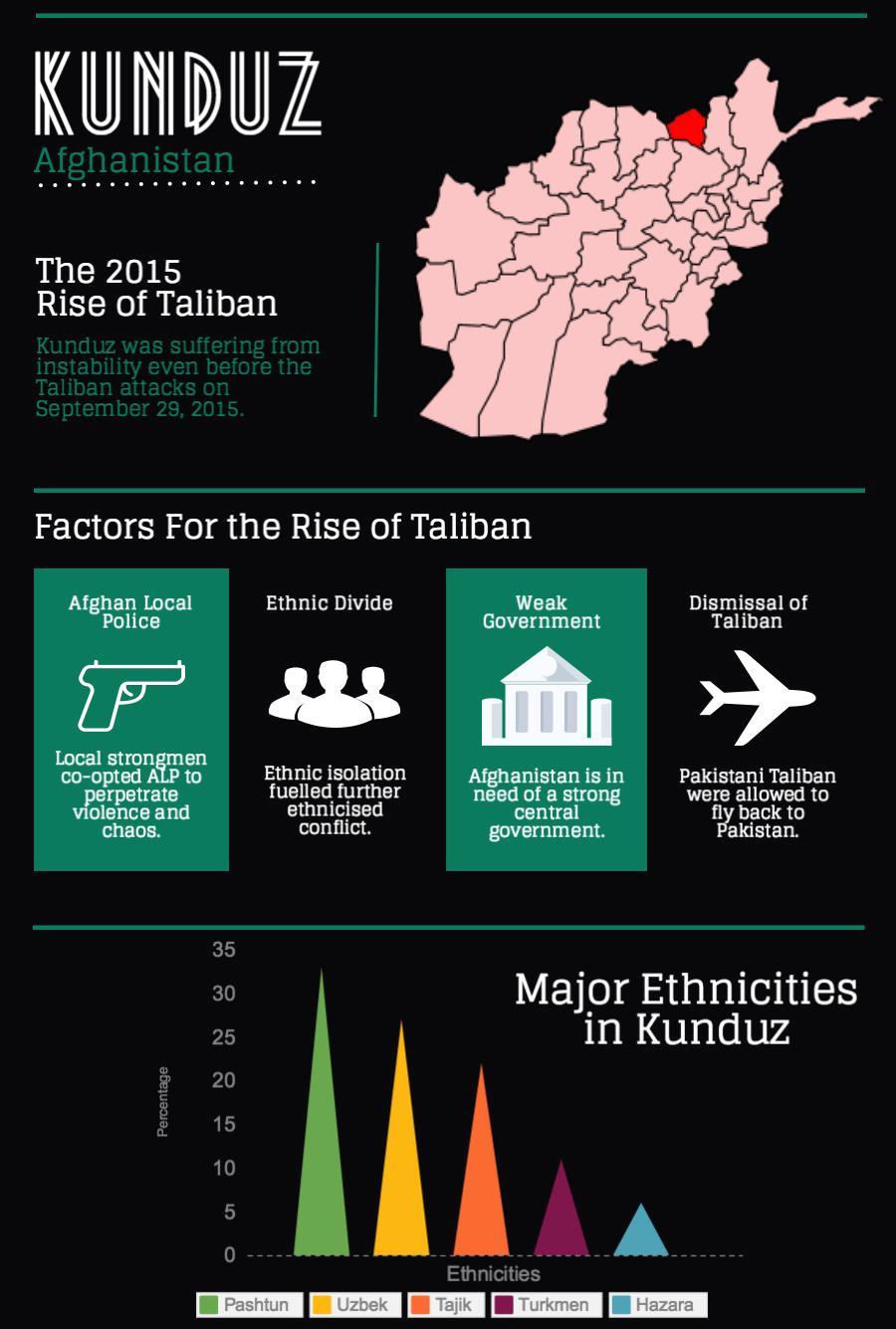There has been much talk about the city of Kunduz due to its recent takeover by Taliban forces on September 29. Soon after, on October 3 the U.S. airstrike of a MSF hospital, which was covered in the first part of this series, further put Afghanistan’s northern city in the headlines. But despite the popular belief, Kunduz faced instability even before the recent Taliban attacks. Over time locals have repeatedly expressed their frustration with the government. They have felt abandoned and left at the hands of local militia leaders and strongmen, which include the Afghan Local Police (ALP). This part of the Kunduz series will examine the different factors, which gave way for the rise of Taliban in northern Afghanistan.
Cooperation for Peace and Unity (CPAU), an Afghan-led non-for-profit organization that has been working towards sustaining peace in Afghanistan since 1996 released a conflict analysis report on Kunduz city in 2009. Even though the report is six years old, all the implications for turmoil in the city still apply today. According to the report most of the instability is derived from financial related conflict due to the mixed economy of Kunduz. The city is used as a major trafficking route for opium and heroin (though it does not produce the crop itself) through Central Asia to Europe. Consequently, Kunduz attracts a high level of criminality because whoever controls the region has the power over the drug smuggling routes.
Many analysts believe that the rise of Taliban in Kunduz was inevitable. Sarah Chayes, an American journalist who lived and worked with coalition forces in Afghanistan blames the corrupt Afghan government officials for the rise of Taliban among other things. When asked by a Huffington Post reporter whether or not the Taliban takeover of Kunduz could have been prevented Chayes replied,
“I just looked at my notes from that first trip I took to Kunduz with the ISAF command group — when Kunduz was emerging as a serious security problem. It was on May 17, 2009. But the U.S. government made a decision — finalized in 2011 — not to prioritize governance issues in its handling of Afghanistan. Also, not to call the government of Pakistan on its active support for Taliban and Haqqani insurgents. Once those two decisions were made, it was impossible to prevent the current capture of Kunduz. But if either of those decisions had gone the other way, I think this was eminently preventable.”
Chayes’ analysis focuses on four important factors that helped facilitate the Taliban takeover, they include: the under trained Afghan Local Police (ALP), ethnic divide in the country, Afghanistan’s corrupt government officials, and lastly the dismissal of Pakistani Taliban insurgents in 2001.
Afghan Local Police
During the summer of 2010 former Afghan President Hamid Karzai established the ALP initiative with the help of American General Petraeus under the Ministry of Interior. They were trained by American Special Forces and were established in order to fight the Taliban. The ALP was supposed to be supervised by the local elders in order to assure that no attacks took place against locals.
Chayes did not agree with the initiative from the beginning. The ALP was not well trained. The local militia started committing human rights abuses, scourging their neighbours and giving loyalty to the local strongmen instead of the village elders. Chayes argues that such behavior led to the initial rise of Taliban in 1994. The formation of ALP created more problems than it solved because it set the pretext for local strongmen to create their own local militias and call them “ALP”.
Ethnic Divide
The second reason for the Taliban insurrection is the ethnic divide that still exists in Afghanistan since the civil war in 1991. Kunduz is the fifth largest city located in Northern Afghanistan. In terms of demographics, it is made up of a mixed population, which includes 33% Pashtun, 27% Uzbek, 22% Tajik, 11% Turkmen, and 6% Hazara. Like other provinces in Afghanistan, Kunduz is divided along ethnic lines, which means that other ethnic groups often see government officials as a threat depending on their ethnicity. In terms of ALP, the Pashtun population for example will give its loyalty to Taliban who are largely Pashtun when ALP units are led by non-Pashtuns in order to defend themselves against abuses executed by the militia.
According to CPAU findings, most of the instability arises from land conflicts associated with inheritance and returning refugees. Land conflict between Pashtuns, and Tajiks and Uzbeks is a major unresolved issue. The report analyses the alienation of Pashtuns in land tenures by commanders resulting in further ethnicised conflict in the region due to ethnic polarization.
Weak Government
Afghanistan has not had an official defence minister for over a year due to the recent national elections. The two leading presidential candidates were accused of forging thousands of votes in the close elections. Pressure led the two candidates to govern together, one as president and one as a chief executive, a position that did not exist in the Afghan constitution until now.
Afghan President Ashraf Ghani was well aware of the national security threats Kunduz province imposed. He installed a new governor, chief of police, and head of intelligence in an attempt to increase security and decrease the Taliban threat. His hopes of turning Kunduz into a model city for other cities to look up to were smashed by growing and apparent government corruption.
Chief Executive and a northerner, Dr. Abdullah Abdullah in an interview with New York Times stated, “positive change had not taken place in Kunduz; the people were not happy.” The abandonment of the city by the central government fueled the ongoing conflict and as a result locals projected increasing support for various militia groups.
Dismissal of Taliban
Lastly, Kunduz was the last major city held by the Taliban before the U.S. backed Afghan Northern Alliance forces took over in 2001. The Americans allowed hundreds of Pakistani Taliban, Al Qaeda fighters and senior Taliban figures to flee back to Pakistan by the Americans. This easy withdrawal encouraged Taliban to maintain their roots in the city, which led to their rapid rise.
Recent Developments
U.S. has agreed to compensate those killed and injured by the airstrikes in Kunduz’s MSF hospital. The families of those who were killed will receive funds in the form of condolence payments.
The Taliban since their resurgence have declared their withdrawal from Kunduz stating that they achieved their goal during their short reign. They freed hundreds of fighters from city’s prison and captured different military equipment. Zabihullah Mujahid, the Taliban spokesman said they withdrew in order to protect the civilians from future air raids. However Taliban fighting has continued in the southern city of Ghazni. President Obama has also recently announced the extension of U.S. military mission in Afghanistan beyond 2016. About 5,500 troops will remain in the country in order to further train the Afghan National Army (ANA).
Afghanistan has been at war for 14 years since 2001. It has seen a peak of 140,000 NATO forces in 2011 alone. The most vital question remains unanswered, will 5,500 U.S. troops be able to make a difference in training the ANA when more than 10 years of training did not prepare the army to fight off its biggest enemy, the Taliban, in one major city?
More than arms, Afghanistan is in a dire need of a strong and transparent central government. Increasing the trust of civilians in a central government will decrease the loyalty given to militia leaders and local strongmen who at this time provide them with more security than the state.





